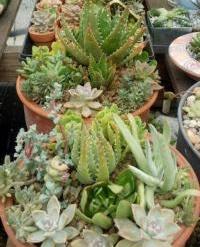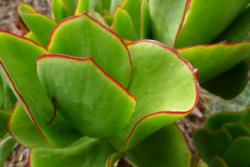Succulents

Sections
Succulents from Master Gardener sales
For more information, see Growing Succulents (pdf)
Soil
Most succulents require soil with good drainage and aeration. For plants in pots, you can buy a succulent soil mix or make your own by adding coarse perlite, crushed lava, or pumice to potting mix. But do not add a layer of gravel at the bottom of a pot; that actually makes drainage worse, not better.
For plants in the ground outdoors, amending with crushed lava and mounding up the soil will help promote good drainage.
Water
In general, succulents do best with infrequent watering, as they approach dryness, rather than keeping the soil constantly moist. Their fleshy roots and stems will easily rot if they are overwatered.
Because succulents store water in their fleshy leaves, they don't wilt like other plants do, but the leaves may start to look desiccated as the plant draws water from them. Observe your plants to learn the visual cues for when they need water.
Fertilizer
Plants in pots may deplete the nutrients in the potting mix and need occasional fertilizing to look their best. For succulents, a light dose of fertilizer once or twice during their growing season may be all that they need. Plants in the ground are unlikely to need extra fertilizer.
Sun exposure
While succulents may not require much water, they are not necessarily ‘desert’ plants. Many succulents will look better if given a little shelter from hot afternoon sun in the summer. Some can even be grown indoors. Too much sun may lead to some plants looking parched and sunburnt. But if given too little sun, other plants may grow lanky stretching for the light. Try to provide each succulent with the lighting conditions it prefers.Cold tolerance
Some succulents can tolerate light frosts or even severe freezes. Many plant tags will tell you the plant’s cold tolerance. But if you don’t know, assume that they will need protection if the temperature is going to dip below freezing.
Pest and disease control
The most common problems for succulents are incorrect watering or incorrect sun exposure. But like any plant, they can also have pest problems. Here are links to information about some common pests.
Maintenance
Like any perennial, succulents need occasional maintenance, such as being deadheaded after flowering, pruning back if becoming overgrown, having dead leaves removed, or being divided if getting crowded. Since succulents store water in their leaves, they don’t wilt like other perennials, making them quite easy to work with. It’s best to divide and transplant them when they are starting their growth period. (Some are summer growers; some are winter growers. See Succulent Growing Seasons.)
Propagation
Succulents can be propagated in a variety of ways, depending on the type of plant: separation (such as pups forming around an agave or aloe), cuttings, or even seed. When taking cuttings, the stem should be allowed to callous over before planting to prevent rotting.







